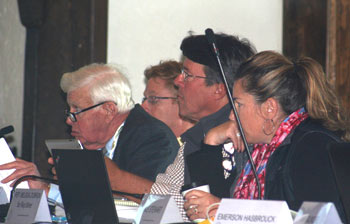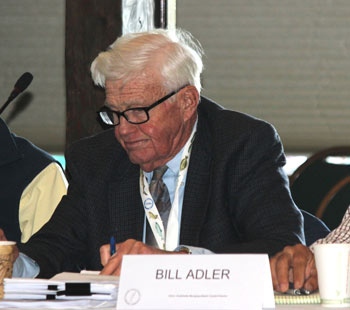Lobster & the Future of Bait
continued from December 2016 Homepage

David Simpson, center, ASMFC also said it was important to define the meaning of “actively fished traps” in the addendum. “It’s an important detail, because I suspect it varies widely by state, based on the type of information they collect.”
“Despite attrition among the fleet and fewer traps fished for lobster, declines have continued,” according to the ASMFC.
Declines in the offshore fishery were evident as well, although not as severe.
“However, the offshore portion of the SNE stock likely depends on nearshore larval settlement and offshore migration as the source of recruits (e.g., young of the year lobsters),” according to the ASFMC. “Therefore, the offshore component is expected to see eventual declines as well.”
The addendum includes management options aimed to increase egg production 20 percent, 40 percent, or 60 percent, with combination of the various measures to achieve those increases.
The SNE fishery occurs in four different management areas. The inshore areas are delineated as Lobster Conservation Management Area (LCMA) 2, 4, 5, and 6. Offshore waters are delineated as LCMA 3. Maine’s inshore lobster fishing grounds, which are in good shape, are LCMA 1.
Board chairman David Borden raised the question of where the management measures should apply. The board considered whether new management measures should apply in offshore LCMA 3, since LCMA 3 contains both the Gulf of Maine/Georges Bank and SNE stocks.
“One of the great challenges in the lobster fishery is our biological stock areas don’t match with the management areas, particularly LCMA 3,” said Borden. “Historically, action in LCMA 3 and Southern New England have occurred throughout Area 3. But given the potential severity of this addendum, the PDT [plan development team] thought it better to have it apply just to the southern portion of Area 3, given that the Gulf of Maine stock is in good condition and is not overfished.”
David Simpson, from ASFMC Connecticut, wanted to know how additional season closures might affect the fishery.
“We’re already closed for, basically, the entire fall,” said Simpson. “If we were to close July and August, my sense is, for Long Island Sound, that would represent a lot more than a 20 percent reduction in exploitation. So I want to make sure, when we go out to public hearings, that we have numbers that are realistic.”
Doug Grout, from New Hampshire, wondered if measures implemented in offshore Area 3 would impact federal permit holders and therefore be in conflict with national standards established by the Magnuson Stevens Act.
Peter Burns, with the National Marine Fisheries Service (NMFS), said NMFS already has federal permit holders declare where they fish. “So this is similar to that, where somebody who is already qualified to fish in Area 3 can voluntarily decide if they want to be in the eastern or western part,” said Burns. “That’s something we can look at in the context of this draft addendum.”
Borden said he was concerned about the closed season proposal, which would require fishermen to remove their traps from the water.
“I point out that 50 percent of income, almost $20 million, is generated by the crab fishery, which takes place at the same time the lobster fishery takes place,” said Borden. “I think we have to…be clear, in any public hearing, exactly what’s going to take place and what the impacts are.”

Bill Adler, Mass Lobstermen’s Association. “Projections that show egg production will increase with reduced fishing also assume that natural mortality will stabilize at its current level. I don’t see that statement as realistic, because I don’t think natural mortality is going to stabilize,” Adler said.
Bill Adler, from Massachusetts, said projections that show egg production will increase with reduced fishing also assume that natural mortality will stabilize at its current level. He disagreed.
“I don’t see that statement as realistic, because I don’t think natural mortality is going to stabilize,” Adler said.
Adler said he was also concerned that, once a season closed in state waters, fishermen would simply move their traps further out into federal waters.
“That’s part of the confusion and complications this plan has,” he said.
Some commissioners expressed interest in getting input from the each area’s Lobster Conservation Management Team (LCMT), industry-led groups charged with advising the the board and recommending changes to the management plan within their areas, before sending the draft addendum out for public hearing. One commissioner said he was contacted by industry members asking to allow the LCMTs to provide input before the document goes to the general public.
Pat Keliher, ASMFC commissioner and Maine Department of Marine Resources commissioner, said, “I personally think input from the industry is always a benefit.”
Brandon Muffley, a New Jersey proxy, said that, while he appreciated the idea of getting LCMT input before going to public hearings, it didn’t seem likely they would have additional management options.
“The PDT has considered all the options,” Muffley said. “I don’t’ know what additional options the industry will give us that are different….I understand we want them to evaluate what’s in here. But I don’t know what going back at this point gains us in terms of additional things to consider.”
“I don’t think the industry will come up with a new, unforeseen strategy,” said Mark Gibson, from Rhode Island. “But they’re challenging some of the suppositions the Technical Committee and PDT made relative to industry behavior, and I think they showed we should afford them the opportunity to respond.”
Simpson said there are still questions to be resolved in the draft anyway.
“I think some of us need to get more comfortable with this, whether we take a two-step process, which might be an informational meeting, or a public hearing,” said Simpson. “I still have questions to resolve myself,” including the question of how season closures and trap reductions would work as a means to reduce exploitation, and the reliability of the data used to gauge potential measures against egg production. Simpson said Long Island Sound has already seen good success in achieving a reduction in exploitation with a fall closure, but the Technical Committee, he said, seem to be saying it’s not enough and needs to be paired with other measures. Ultimately, he said, he was concerned about the potential for consolidated traps into the hands of the most-efficient operators in the name of reducing exploitation.
Simpson also said it was important to define the meaning of “actively fished traps” in the addendum. “It’s an important detail, because I suspect it varies widely by state, based on the type of information they collect.”
Dan McKiernan, from Massachusetts, said he favored the idea of allowing the industry time over the next couple of months to review the draft. He said one of his concerns is that the draft doesn’t describe the impact of the proposed measures on the Jonah crab fishery.
“We created the Jonah crab plan on the argument that it’s a mixed crustacean fishery,” McKiernan said. “Yet this doesn’t describe the impacts of seasonal closures on Jonah landings.”
Adler wanted to know if the Technical Committee took into consideration the current trap reduction program already in place, and what it will have achieved when it’s completed.
Addendum XVIII established trap reductions in Areas 2 and 3. A 25 percent reduction in year 1 was followed by a series of 5 percent reductions for five years. The first of these reductions took place at the start of 2016 fishing year. In total, 33,880 traps were retired in Area 2 and 8,663 traps were retired in Area 3.
“I don’t know if they did that or whether they just said, ‘Right now, this is where we are and you have to go down this number in trap reductions alone in order to achieve this amount,’” Adler said. “And I don’t know if they anticipate that trap reductions that are still ongoing have achieved something….What you’ll hear at the public hearings is, ‘Let what we’ve already done, work.’ There needs to be some response to that when we go to public hearing…They might have already achieved what they’re looking for.”
Emerson Hasbrouck, from New York, wanted to know if the benefits of removing ghost gear have been analyzed in terms of egg production. “We’ve already removed 16,000 abandoned pots out of Long Island Sound,” Hasbrouck said. “There’s three or four times that amount still, just in Long Island Sound. I don’t know if we can get at some level of increased egg production by removing ghost gear and how that might factor into this.”
Simpson said, while it’s important to make progress in reducing fishing mortality, “I don’t want in the addendum to create irretrievable harm to the industry in creating trap limits….I want to make sure we’re flexible enough in this addendum, and must pair this with that, that we do no harm. I think, having already started on the season closure track and seen fishermen adjust to finding other things to do during those times, I’m thinking that’s what we would do. But a gauge increase would be disproportionately burdensome on Long Island Sound, which has smaller lobsters than Areas 2, 4, and 5.”
In the end, the board decided to provide an opportunity for LCMT input prior to approving the document for public comment. States were scheduled to submit industry comments to the ASFMC by Nov. 30. Those will be reviewed by a subset of commissioners and the Plan Development Team. The board is scheduled to consider approving Draft Addendum XXV for public comment in February 2017. Implementation would be in 2018.
In addition, the board decided there was a need for improved harvester reporting in the lobster fishery. The ASMFC’s Lobster Reporting Work Group recommended a higher percentage of harvester reporting, collection of additional data on trap hauls, soak time, and gear configuration, and the incorporation of vessel monitoring systems (VMS) on lobster vessels. The board will consider the initiation of an addendum in February 2017 to examine reporting in the fishery.
